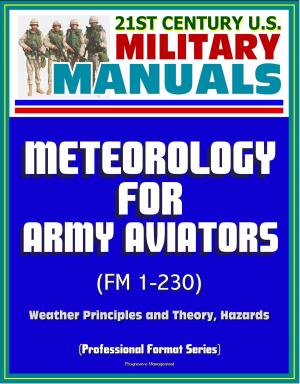U.S. Army Irregular Opposing Forces (OPFOR): Insurgents, Guerrillas, Criminals, Noncombatants, Terrorism, Functional Tactics, Techniques, Procedures, Hybrid Threat for Training
Nonfiction, History, Military| Author: | Progressive Management | ISBN: | 9781311752253 |
| Publisher: | Progressive Management | Publication: | January 9, 2015 |
| Imprint: | Smashwords Edition | Language: | English |
| Author: | Progressive Management |
| ISBN: | 9781311752253 |
| Publisher: | Progressive Management |
| Publication: | January 9, 2015 |
| Imprint: | Smashwords Edition |
| Language: | English |
This training circular (TC), as part of the TC 7-100 series, addresses the irregular opposing force (OPFOR), which in Army training exercises represents a composite of actual threats and enemies that comprise irregular forces. The three primary categories of irregular forces portrayed by the OPFOR are insurgents, guerrillas, and criminals. These actors may operate separately or in conjunction with one another and/or combined with regular military forces as the Hybrid Threat (HT) for training. This TC also addresses other actors present in an operational environment (OE), who may be affiliated with the irregular OPFOR through willing support or coercion, and/or may be passive or unknowing supporters of the irregular OPFOR.
Irregular forces are armed individuals or groups who are not members of the regular armed forces, police, or other internal security forces (JP 3-24). The distinction of being armed as an individual or group can include a wide range of people who can be categorized correctly or incorrectly as irregular forces. Excluding members of regular armed forces, police, or internal security forces from being considered irregular forces may appear to add some clarity. However, such exclusion is inappropriate when a soldier of a regular armed force, policeman, or internal security force member is concurrently operating in support of insurgent, guerrilla, or criminal activities.
Irregular forces can be insurgent, guerrilla, or criminal organizations or any combination thereof. Any of those forces can be affiliated with mercenaries, corrupt governing authority officials, compromised commercial and public entities, active or covert supporters, and willing or coerced members of a populace. Independent actors can also act on agendas separate from those of irregular forces.
INTRODUCTION * Irregular Forces * Irregular OPFOR and Hybrid Threat for Training * Tailoring the OPFOR * Chapter 1 - IRREGULAR OPPOSING FORCE FUNDAMENTALS * Hybrid Threat * Capabilities and Intent * Tactics * Interactions of Operational Variables * Principles * Motivations * Support * Blurring of Categories * Comparison and Contrast * Chapter 2 - INSURGENTS * General Characteristics * Insurgent Organizations * Chapter 3 - GUERRILLAS * General Characteristics * Guerrilla Organizations * Guerrilla Brigade * Guerrilla Battalion * Guerrilla Company * Guerrilla Platoon * Guerrilla Hunter-Killer Company * Hunter-Killer Group * Tactics and Techniques * Chapter 4 - CRIMINALS * Characteristics * Motivations * Criminal Organizations * Command and Control * Criminal Activities * Chapter 5 - NONCOMBATANTS * General Characteristics * Armed Noncombatants * Unarmed Noncombatants * Unarmed Combatants * Chapter 6 - TERRORISM * Terrorism in Complex Operational Environments * Motivations * Terrorism Planning and Action Cycle * Terrorism Actions * Tactics, Techniques, and Procedures * Terrorism Trends and Emergent Vectors * The Specter of Terrorism * Chapter 7 - FUNCTIONAL TACTICS * Functional Organization of Forces and Elements * Types of Offensive Action * Types of Defensive Action * Irregular OPFOR in Hybrid Threat Tactics
This training circular (TC), as part of the TC 7-100 series, addresses the irregular opposing force (OPFOR), which in Army training exercises represents a composite of actual threats and enemies that comprise irregular forces. The three primary categories of irregular forces portrayed by the OPFOR are insurgents, guerrillas, and criminals. These actors may operate separately or in conjunction with one another and/or combined with regular military forces as the Hybrid Threat (HT) for training. This TC also addresses other actors present in an operational environment (OE), who may be affiliated with the irregular OPFOR through willing support or coercion, and/or may be passive or unknowing supporters of the irregular OPFOR.
Irregular forces are armed individuals or groups who are not members of the regular armed forces, police, or other internal security forces (JP 3-24). The distinction of being armed as an individual or group can include a wide range of people who can be categorized correctly or incorrectly as irregular forces. Excluding members of regular armed forces, police, or internal security forces from being considered irregular forces may appear to add some clarity. However, such exclusion is inappropriate when a soldier of a regular armed force, policeman, or internal security force member is concurrently operating in support of insurgent, guerrilla, or criminal activities.
Irregular forces can be insurgent, guerrilla, or criminal organizations or any combination thereof. Any of those forces can be affiliated with mercenaries, corrupt governing authority officials, compromised commercial and public entities, active or covert supporters, and willing or coerced members of a populace. Independent actors can also act on agendas separate from those of irregular forces.
INTRODUCTION * Irregular Forces * Irregular OPFOR and Hybrid Threat for Training * Tailoring the OPFOR * Chapter 1 - IRREGULAR OPPOSING FORCE FUNDAMENTALS * Hybrid Threat * Capabilities and Intent * Tactics * Interactions of Operational Variables * Principles * Motivations * Support * Blurring of Categories * Comparison and Contrast * Chapter 2 - INSURGENTS * General Characteristics * Insurgent Organizations * Chapter 3 - GUERRILLAS * General Characteristics * Guerrilla Organizations * Guerrilla Brigade * Guerrilla Battalion * Guerrilla Company * Guerrilla Platoon * Guerrilla Hunter-Killer Company * Hunter-Killer Group * Tactics and Techniques * Chapter 4 - CRIMINALS * Characteristics * Motivations * Criminal Organizations * Command and Control * Criminal Activities * Chapter 5 - NONCOMBATANTS * General Characteristics * Armed Noncombatants * Unarmed Noncombatants * Unarmed Combatants * Chapter 6 - TERRORISM * Terrorism in Complex Operational Environments * Motivations * Terrorism Planning and Action Cycle * Terrorism Actions * Tactics, Techniques, and Procedures * Terrorism Trends and Emergent Vectors * The Specter of Terrorism * Chapter 7 - FUNCTIONAL TACTICS * Functional Organization of Forces and Elements * Types of Offensive Action * Types of Defensive Action * Irregular OPFOR in Hybrid Threat Tactics















